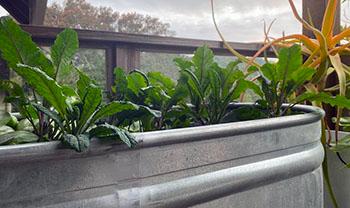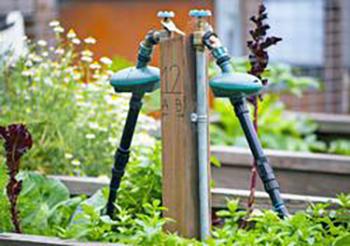Fall 2022
Container Gardening: Water saving Techniques

Container gardening in small spaces, such as a patio near your kitchen, is fun and can be very productive. Caveat: because the sides of containers are exposed to direct sun and drying air, containers tend to lose water at a faster rate than in-ground vegetable beds. We are in a third straight year of rain and snow deficits and a Stage-2 water emergency, so rapid water loss is not good.
What are some ways for a container gardener to reduce water loss and maximize the availability of moisture for plant use? Here are some great tips:
- Use plenty of organic compost and coconut coir in your potting mix. Compost and coir absorb and retain water, then release it slowly into your plant’s root systems. Compost adds beneficial nutrients also.
- Choose the right type of container. Containers with non-porous sides, such as metal, fiberglass, plastic, or glazed pottery do not lose water through their sides. Avoid terra cotta clay or wood containers because wood and clay are porous and allow water to evaporate. Also, large containers dry out more slowly than small containers and light colors are less hot than dark colors.
- Use a self-watering insert at the bottom of your pot to catch draining water.
- Save household waste-water to use for vegetable containers. For example, catch water in a bucket while waiting for your shower water to warm up, then use it for watering your container plants. However, do not recycle “dirty” water as it may contain harmful bacteria.
 Eggplant in Light-colored plastic container with Soaker Hose - Courtesy UCANR
Eggplant in Light-colored plastic container with Soaker Hose - Courtesy UCANR - Use 3-4 inches of organic mulch around your plant bases to allow water into the root system but slow water loss on warm days. Straw or hay can be used but beware of weed seed. Shredded leaves or fine bark material is also good. You can also mulch with grass clippings if you start with a thin layer (for example ½ inch) and allow that grass layer to dry thoroughly before adding another layer.
- Regularly check your container’s moisture levels in the plant root zone. If containers are watered with a hose or watering can, check each time before providing more water. Using the “hand squeeze” test method on soil in the root zone is a good approach if it’s possible to get a handful of soil without disturbing the plant roots. Squeeze it in your hand and then open your hand again. If the container soil stays clumped together, there is sufficient moisture still. But if the soil becomes loose and falls apart, more water is needed. If you can’t check by hand as frequently as you’d like, automated spigot-connected, battery-operated irrigation timers and moisture meters are sold at nurseries and garden centers. You can calibrate the meter’s readings initially with the hand squeeze method. The moisture meter should read in the center of the dial when the moisture level is “just right” for your plants. If the moisture meter reads below that level, adjust the irrigation timer’s run time or frequency to add more water.
 Spigot-connected, battery-operated irrigation timers - Courtesy UCANR
Spigot-connected, battery-operated irrigation timers - Courtesy UCANR
Great veggies and ornamental plants grown in containers require some vigilance to make sure water levels are adequate for their needs, while at the same time making sure that we don’t waste our dwindling water resources. You can be both a water-wise citizen and enjoy a great veggie harvest or spectacular flowers.
Article by David George and Terry Lippert, UC Master Gardeners of Contra Costa County
Photo credits: UCANR


